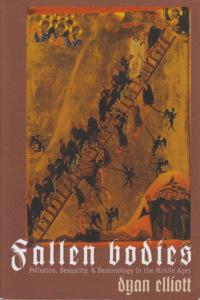 Less common than it once was, the term “Dark Ages” was formerly used to denote what in Europe was known as the Medieval Period.We now know that the pervasive darkness ascribed to the time was only partial: science, legal thinking, and rationalism were well underway.Nevertheless, the sway of the church was enormous, and even until and beyond the days of Isaac Newton, the supernatural was assumed to exist. Dyan Elliott’s Fallen Bodies: Pollution, Sexuality and Demonology in the Middle Ages is a fascinating journey through this contradictory time.Elliott explores how the mysteries of sex (nocturnal emissions and menstruation loom large among them) played important roles in the development of Catholic theology that ultimately led to the close association of demons and witches.Concerns with priestly purity, largely due to concerns about transubstantiation, led to enforced celibacy and the (further) denigration of women.
Less common than it once was, the term “Dark Ages” was formerly used to denote what in Europe was known as the Medieval Period.We now know that the pervasive darkness ascribed to the time was only partial: science, legal thinking, and rationalism were well underway.Nevertheless, the sway of the church was enormous, and even until and beyond the days of Isaac Newton, the supernatural was assumed to exist. Dyan Elliott’s Fallen Bodies: Pollution, Sexuality and Demonology in the Middle Ages is a fascinating journey through this contradictory time.Elliott explores how the mysteries of sex (nocturnal emissions and menstruation loom large among them) played important roles in the development of Catholic theology that ultimately led to the close association of demons and witches.Concerns with priestly purity, largely due to concerns about transubstantiation, led to enforced celibacy and the (further) denigration of women.
It would be difficult to summarize this insightful book.Although relatively brief, it packs a wallop.Concerns about purity go back to the Bible and before.Ancient cultures had recognized aspects of contagion and knew that some diseases spread by contact.Their perception of biology was “scientific” according to their current understanding, but it lacked microscopes and knew no shortage of supernatural entities.Demons had great explanatory value in such a world.As Elliott shows, they often appear in disquisitions about sex.How can spiritual beings engage in physical relations with human bodies?What were they made of?Were they all bad?Although demons had explanatory value they also raised many questions.
Fallen Bodies draws correlations between the dismissal of priests’ wives and the evolution of witches.As the Eucharist became more and more holy, stricter controls had to be placed on consecrating hands.Sex was the great source of pollution, and the Virgin Mary became rather less human through her own miraculously sterile conception.The implied misogyny may not have been so much intentional as a reflection of the struggle to understand what modern medical science generally explains materially.We still grapple with the mystery of life.Conception can be viewed clinically, and biological responses can be “explained” scientifically (anyone who’s been in love will admit to the mystery of it, though).Denizens of the Middle Ages worked with the tools they had to make sense of a world often bewildering.Even physics still has to deal with quantum realities.History teaches by its unfortunate missteps.Someday those who “govern” the world may learn to read it and exorcise demons now otherwise readily explained.
